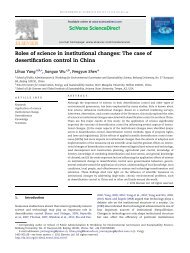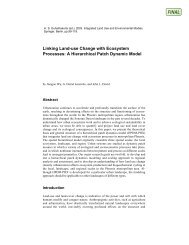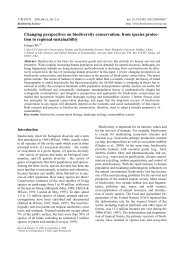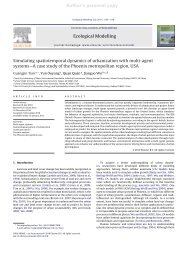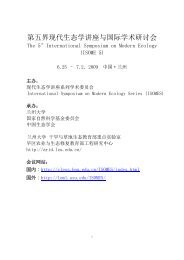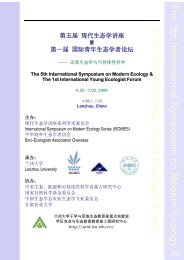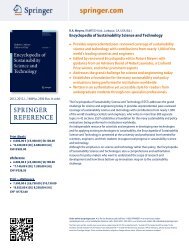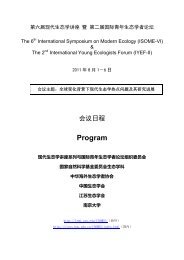Download PDF - Springer
Download PDF - Springer
Download PDF - Springer
You also want an ePaper? Increase the reach of your titles
YUMPU automatically turns print PDFs into web optimized ePapers that Google loves.
216 BERLING-WOLFF AND WU<br />
is widely recognized that the spatial pattern of a landscape affects ecological processes<br />
(Turner, 1989; Wu and Loucks, 1995). Understanding the reciprocal relationship between<br />
spatial pattern and ecological processes is at the heart of landscape ecology (Pickett and<br />
Cadenasso, 1995; Wu and Hobbs, 2002). Urban landscapes exhibit the most conspicuous<br />
spatial heterogeneity of all landscapes, and the spatial form a city takes affects physical,<br />
ecological and sociological processes within (Pickett et al., 1997; Zipperer et al., 2000;<br />
Wu and David, 2002). A landscape ecological perspective for urban ecosystems is not only<br />
appropriate, but imperative as well. The study of urban ecosystems needs to be considered<br />
in a landscape context, and the patterns and processes of urbanization should be integrated<br />
if the ecology of cities is to be fully understood (Foresman et al., 1997; Wu and David,<br />
2002).<br />
An important first step to understanding the ecology of cities is to adequately quantify<br />
the urban landscape pattern and project its spatiotemporal dynamics. Urban growth models<br />
play an instrumental role in this process. Urban modeling started in the 1950s and has<br />
experienced ups and downs in the past several decades (Lee, 1973, 1994; Harris, 1994).<br />
Several approaches to modeling urban growth have been developed by urban planners,<br />
geographers, and ecologists, and have been periodically reviewed (e.g., Batty, 1979, 1994;<br />
Harris, 1985; Wegener, 1994; Berling-Wolff and Wu, 2004; Guhathakurta, 2003). Since<br />
the 1980s, one of the most widely used modeling approaches in urban studies involves<br />
cellular automata (CA). Cellular automata are systems of cells interacting in simple ways<br />
but generating complex overall behavior. A cellular automaton (A) is defined by a lattice (L),<br />
a state space (Q), a neighborhood template (l) and a local transition function (f) expressed<br />
in set notation as<br />
A =〈L, Q, l, f〉 (1)<br />
A cell may be in any one of several discrete states defined by Q, and a set of transition<br />
rules, f, determines the future state of each cell as a function of the states of the neighboring<br />
cells. Time is discrete and all cells are updated at each time interval. Cellular automata are<br />
well suited to investigations of urban morphology due to their spatially explicit nature and<br />
capability of generating complex patterns. Indeed, many contemporary urban growth models<br />
in the literature are based on a CA framework. In general, CA is a powerful approach to<br />
modeling open, complex, self-organizing systems that emphasizes the way in which locally<br />
made decisions give rise to global patterns (Wu, 1998; Wu and David, 2002). Couclelis<br />
(1985) suggested that the classic cell-space models are not appropriate for studying specific<br />
urban systems, but rather should only be used to understand the driving forces that shape<br />
urban form. However, CA-based models have recently been applied to specific cities (e.g.,<br />
Batty et al., 1989; White and Engelen, 1993, 1994; Batty and Xie, 1994).<br />
To simulate the urban growth of the Phoenix metropolitan area, we have adapted an<br />
existing urban growth model, the Human-Induced Land Transformations (HILT) model,<br />
which was originally developed for the San Francisco Bay Area (Clarke et al., 1997; Kirtland<br />
et al., 1994). To make HILT applicable to Phoenix, a number of substantial changes had<br />
to be made. To distinguish the significantly modified version of HILT tailored for Phoenix<br />
from the original, we have named it PHX-UGM (Phoenix Urban Growth Model). In this




